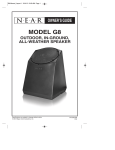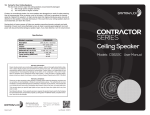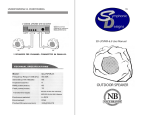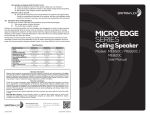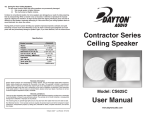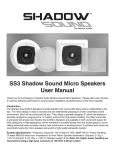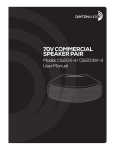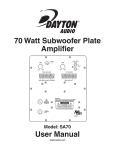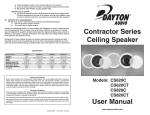Download Elite Series In-Wall Speaker
Transcript
10)Caring For Your In-Wall Speakers
The two most common ways that in-wall speakers are permanently damaged:
1) Not enough power at higher volumes.
2) Too much power at higher volumes.
Contrary to conventional wisdom, far more speakers are damaged as a result of underpowering, than by overpowering. When a receiver runs out of power, it still tries to reproduce the musical
signal by “clipping” the waveform. At loud volumes, this clipping introduces gross amounts of distortion to the speaker, eventually destroying it. If the sound from your in-wall speakers starts to sound
distorted, turn down the volume.
Having plenty of reserve power will help your speakers reproduce dynamic contrasts and quick
transients of music much more effectively. But you do have to exercise good judgement; too much
power will also permanently damage a speaker. Again, if you hear distortion, turn the volume down.
11)Warranty Information
Dayton Audio® products are constructed by industry experts, and are thoroughly tested before
shipment. Dayton Audio® products are warranted for the period of five years. This warranty is limited
to manufacturer defects, either in materials or workmanship. Dayton Audio® is not responsible for any
consequential on inconsequential damage to any other unit or component or the cost for installation or
extraction of any component of the audio system. In the rare case of a product failure, please contact
your place of purchase or call our Customer Support Department at (937) 743-8248.
Elite Series
In-Wall Speaker
Warranty Limitations
There are no other warranties, either express or implied, which extend the foregoing, and there are no
warranties of merchantability or fitness for any particular purpose. The warranty will not cover incidental or consequential damage due to defective or improper use of products. This includes but is not
limited to burnt voice coils, overheating, bent frames, holes in the cone, or broken lead wires.
This warranty gives you specific legal rights and you may also have other rights which vary from state
to state.
Non-Warranty Service: If non-warranty service is required, the product may be sent to the Company
for repair/replacement, transportation prepaid, by calling (937) 743-8248 for details, complete instructions, and service fee charges.
User's Manual
www.daytonaudio.com
ESIW-08
© 2008 Dayton Audio®
Congratulations on the purchase of your Dayton Audio® Elite Series In-Wall Speaker System.
These speakers were manufactured with high quality components and engineered to deliver superior
sound performance.
Like many of the products sold by Dayton Audio®, these in-wall speakers were designed for ease
of installation.
Please read through the instructions completely before you begin your installation.
1)
Parts Inventory
Your In-Wall kit should include the following:
• 1 pair of Dayton Audio® In-Wall Speakers with Grills
• 2 metal retrofit brackets
• 1 package of hardware
• 1 pair of cardboard mounting/paint masking templates
2)
Installation Tools
The Dayton Audio® In-Walls can be installed with the following simple
tools which you supply:
• Pencil
• Masking tape
• Drill & drill bits
• Utility knife
• Keyhole saw*
• #2 Phillips screwdriver
• Wire cutters & wire strippers
• Small level**
• Stud finder**
* Recommended for use if installing in plaster walls.
** Optional tools to make the installation easier.
3) Speaker Location
To achieve the best performance from your Dayton Audio®
speakers, it is important to carefully select the location for
installation.
Your in-wall speakers should be installed 5 to 8 feet apart
to ensure proper stereo imaging. If possible, mount each
speaker the same distance from the corners on a common
wall. Keep the speakers at least 2 feet away from the corners
of the room to avoid overemphasized bass reproduction.
The speakers should be located so that the tweeter height
is at the same level, or slightly above the listener’s ear. You must now decide whether the primary
listening will be done standing or in a seated position. Remember, for the best stereo imaging, the
listening position should be directly in-between the speakers with the tweeters at ear level.
4) Speaker Installation
Once you have selected the location for your speakers, you are now ready
to install them.
CAUTION: Be certain that there are no electrical wires, water pipes, or heating ducts in the planned installation area before you start drilling or cutting into the wall. If there is an electrical outlet nearby, turn off
the circuit breaker to avoid possible injury.
The in-wall speakers are designed to be mounted to the wall area between
the studs. Once you have selected your location, the next step is to be sure
you are between the studs. By tapping on the wall, you will hear a hollow sound when between two
studs and a sharper, more solid sound when right on top of, or close to a stud.
An easier, more accurate method for finding the location of wall studs is to use a stud finder.
Once you have established that your chosen location is between two studs and that there are no
obstructions in the wall, tape your speaker template to the wall and lightly trace around the inside
opening with a pencil. To ensure that your speaker template is straight, you may want to use a level
before you mark the wall.
Drill a 1" hole in the center of the template outline. Next, using a piece of stiff wire (a coat hanger
works well), bend it 8" from the end at a 90 degree angle. Insert the bent part of the coat hanger
into the 1" hole and rotate the wire in a complete circle to check for obstructions. If
the wire hits a stud on either side, reposition your template to the left or right and
re-do the light pencil outline. Keep the pilot hole within the template outline.
If the walls are made of drywall, simply cut the marked area with your utility
knife. If your home has plaster walls, then you will need to drill pilot holes at the four
corners of the template outline, and cut the speaker opening using a keyhole saw.
Check the speaker opening by placing one of the speakers into the hole. The
speaker should fit loosely into the hole.
Repeat these steps for the other speaker.
5) Speaker Wire
Don’t compromise sound quality by using thin, inexpensive speaker wire. We
recommend using a high quality oxygen free copper wire. For runs of 10 to 50
feet, choose a 16 gauge wire. A 14 gauge wire should be used for runs greater
than 50 feet.
6) Speaker Hook Up
When hooking up the wires to the speakers, be sure to observe proper polarity.
Make certain you connect the positive lead from the receiver to the red terminal
on the speaker and the negative lead from the receiver to the black terminal on
the speaker ("B"). This is very important because improper polarity will cause unwanted frequency
response aberrations. Split the two conductors of the speaker wire apart about 2-4 inches so that
they form a “Y”. Using wire strippers, remove about 1/2" of insulation from each wire. Twist the
strands of wire tightly before inserting them into the spring loaded terminals.
When hooking up the speaker wires to the stereo receiver, be sure the positive lead again goes
to the red output terminal and the negative lead goes to the black output terminal.
7) Final Installation
To install the speakers into the ceiling, first remove the grills using a small paper clip or a grill
removal tool. Turn the "Angle Lug Installation Clamps ("A")" so they are positioned as in the illustration. This way, they will clear the cut out hole for installation.
Insert speaker assembly into hole, and begin to tighten installation screws. As you start to turn
each screw, the "Angle Lug Clamps" will rotate outward
to engage ceiling material. ("C")
CAUTION: Do Not Overtighten the Clamps. Too much torque may snap off the lug, causing the
speaker not to seat securely. A snug fit is all that is
necessary to assure proper performance.
8) Painting Speakers
If speaker frame is to painted, either before or after installation, use the "Paint Masking Template" to cover the
woofer/tweeter assembly to prevent damage to them. Do
not try to paint the frame and grill assembly together.
The grill should always be painted separately. Do not put
such a heavy coat of paint on the grill that the perforations are blocked.
9) Troubleshooting
Should your speakers not work properly, check the following:
No sound from speakers:
• Most stereo receivers have an A/B speaker selector switch. Make certain that this switch
is in the proper position.
• Mute feature is activated.
One speaker is playing while the other is not:
• Check the balance control on the receiver. Make sure it is centered.
• Loose connection at either the receiver or the speaker. Double check connections.
• Bad speaker cable. Replace suspect speaker wire.
Receiver cuts on and off:
• This could be caused by a short circuit between the positive and negative leads. Check
the connections at the back of the receiver, and then at the speaker. Make sure that no
strands of wire from one connector are touching the other connector.





